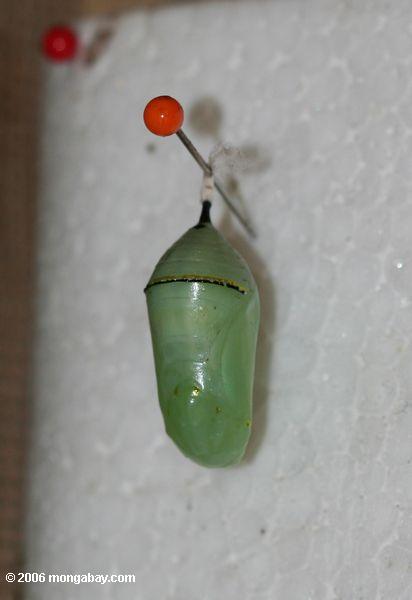|
|

|
|
Chapter 8: Where Mongy learns about butterflies By Christa Maas It was a beautiful morning somewhere in the jungle near Santarem, in the heart of the Brazilian Amazon, where we had set up camp the night before. Or at least it would have been a beautiful morning and a chance to get some much needed rest if it hadn't been for Mongy: "Chriiiisssta" Mongy whispered. "It's really important!" "Mongy, go back to sleep! It's too early!" I complained sleepily. "Mongy, be quiet!" scuffed Rhett." You can be a real nuisance sometimes, you know that?" "But you are missing it," protested Mongy, "go ahead, you can all go back to sleep, but then you'll miss e-v-e-r-y-t-h-i-n-g, and I have been waiting for hours already. It's sooo exciting!" and with a hurt look, (you would have to know Mongy personally to notice when he is being stubborn and when he is being truly hurt!) off he hopped. 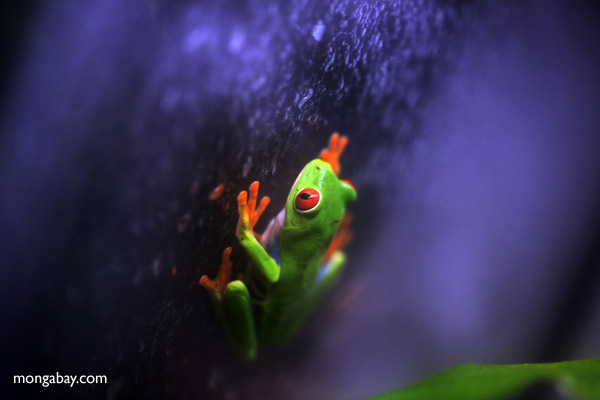
Rhett and I had so far been happily dreaming in our hammocks underneath a nice shady tree, but of course now we were both curious about what it was Mongy had been watching for hours (Mongy watching something for hours? That couldn't be right!) So we both reluctantly got up and trotted after Mongy. "What have you been waiting for, Mongy?" I asked puzzled. "I don't know what it is, but I think I'll eat it! Anyway, it's about to escape." "Escape from what? You are not making any sense, sweetheart" "Well that's because you and Rhett sleep all the time. You don't have time to see the tiny little things the way I do- and then I don't know what they are called and always have to wake you up, and then you complain and..." Mongy rambled on and on. He also neglected to realize that being primarily nocturnal, his waking hours don’t coincide well with us humans. "OK, OK, Mongy we are here now. So tell us what we are supposed to be looking at?"
Rhett and I crouched down to have a better look at a leaf hanging close to the ground in a small clearing, trying to find the source of Mongy's excitement. "Oh, it's a pupa!" I exclaimed surprised "A butterfly pupa. It's already transparent and about to hatch!" "Pooopa" howled Mongy. "Is that what it's called?" He did a couple of summersaults and couldn't stop laughing. "Poopa! Poopa". Rhett and I looked at each other and started laughing. "I really don't see what could possibly be funny about the word 'pupa'" said a small voice. We spun around a saw a little butterfly which had just emerged from the chrysalis while we had been distracted by Mongy. It was stretching its beautifully-colored wings in front of us. "Everyone knows it's called a p-u-p-a; a pupa, and there is nothing funny about it, and please, do not bother me any further as I want to rest now! " "Wow" said Mongy. "You don't have to get all huffy! It is a funny word after all! And how come you are already tired?" "You see, Mongy", explained Rhett. "This butterfly must rest now. After pumping fluid through its wing veins to expand them, the butterfly’s body must dry and the wings harden. Butterflies and moths belong to an order called Lepidoptera. They lay eggs under leaves and soon little caterpillars hatch from them. They lose their skin several times and finally pupate, which means the caterpillar spins a small protective cocoon called a pupa or chrysalis around their bodies, with small hooks to attach it to a protected, safe place. During the pupa stage, which takes about 10-12 days, they turn into moths or butterflies, like this beautiful one here. See its bright orange color with black borders and veins? The color protects them from their enemies." 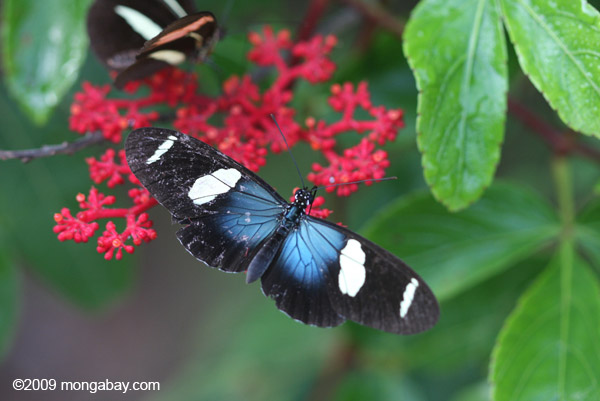
"Hah! Interrupted Mongy. "It makes it look even more delicious and I might even eat it!" "Well, Mongy, I would think about that!" I responded. "Because this one is a Monarch butterfly, and it's poisonous." "Yes" said the Monarch butterfly, now very suspicious of Mongy. "I am very, very poisonous. I am also of the highest royal background. I am King Billy. You may call me 'Your Highness'". "I may still eat you!" growled Mongy. (Mongy is one of the only frogs I know that can transform a croak into a growl) A little later the whole clearing in front of us was full of Monarchs, singing, laughing and playing with the wind. "First you'll have to catch me!" laughed King Billy as he joined them. "I guess you are not the only King, Your Highness," teased Mongy. Rhett continued "Monarchs are very common throughout the USA, America, Canada, Central America, South America and some Mediterranean countries. Some people believe they were brought so far South with the help of ships." "Maybe they were kidnapped by pirates" speculated Mongy wide-eyed. "Some groups of Monarchs migrate over 2000 miles during August, September and October. They fly from Canada and the US to warmer climates in Mexico and California. They live between 2-5 weeks or 8-9 months, depending on when they are born." "But how can they travel, if their life is so short?" asked Mongy. "That's a good question, Mongy" said Rhett "You see, females lay their eggs along the migratory pass, and it can take up to three generations of butterflies to complete the migration." "So if a Monarch butterfly starts in Canada, its daughter might be born in Texas and a granddaughter in South Dakota and a great-granddaughter in – oh, I don't know- Canada?" said a very puzzled Mongy. 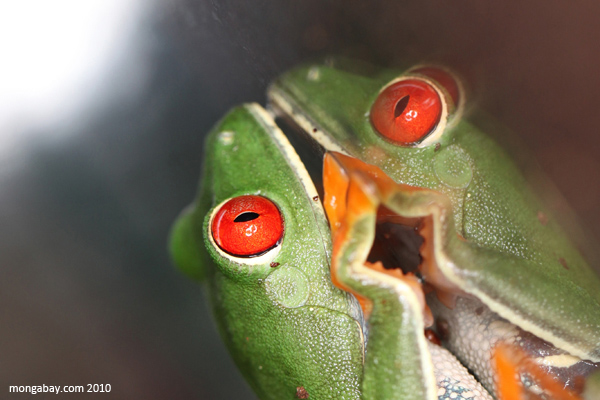
"Yes, Mongy, that's about how it works." "But how do they know where to go?" "Another good question, Mongy. I can see you are paying attention." Mongy was so proud to have asked a good question that he sat up especially straight while Rhett proceeded: "Scientists who have studied this believe it's a combination of factors, like the sun, wind and air funneling through mountain chains or the earth's magnetic field, but no one fully understands it yet" Mongy immediately slumped. "Typical" he complained, "My best questions never get fully answered! It's tough to be so interested in things all the time." Then, with a triumphant hop he proclaimed "HA! If His Snooty Highness doesn't even know how he got here, and not even scientists know that, then he is probably nothing but a stowaway who snuck a free ride on a ship." But Rhett didn't let Mongy discourage him. "In the volcanic mountains of Mexico there is a 366000 acre butterfly sanctuary. But the Mexican government has not been able to protect it and half of it has already been cut down by loggers. Also, new herbicides kill the weeds butterflies and caterpillars need to survive. The monarch butterflies we see here in South America don't migrate. It's warm enough for them, so they don't have to. But as I already mentioned, they don't belong here naturally. They are not endemic, meaning that were brought here." "But South America has lots of other butterflies, doesn't it?" Asked Mongy. "Yes, actually the Atlantic Rainforest is home to 2124 species of butterfly, two thirds of Brazil's butterflies, and of those 913 are endemic, meaning they live nowhere else. Only 10% of the original rainforest still exists and it is extremely important to protect it. Brazil has butterfly species in almost every region, like the Green Longwing or the Tigerqueen of Amazonia, or the Blue Morpho Butterfly; the Cottontail or the Savannah Butterflies. In many regions of Brazil, butterflies are used in medicine or their wings are used to make decorative items for tourists. Some people believe that the scales of butterfly wings can make you blind, which is not true, although they can irritate your eyes. But Monarch butterflies are very common in South America. You know, Mongy, the name King Billy was given to these butterflies by Dutch settlers because the bright orange markings and bright colors reminded them of their Monarch King William." 
"I have beautiful bright colors too and no one calls me King Mongy!" I was starting to lose patience "Mongy, why are you so jealous? Look at them fly! They seem to flirt with the wind; like beautiful, magical little fairies!" "Yes" answered Mongy "that's why I am jealous. I want to fly, too! But I am just a frog and frogs can do a lot of cool stuff, but they can't fly!" He sighed deeply and flopped down in utter desperation. But not for long. Suddenly he leaped up and shouted: "I've got an idea! Christa, people can fly, right? I mean, they build stuff that they can fly in. Why don't you build me something I can fly with?" I sighed. "OK, Mongy... and then I whispered to Rhett "I know that you can do almost anything when you put your mind to it. We better think about this. I know Mongy. He will never let us rest again until he has had his way!" "Yes, my way!" smiled Mongy dreamily. (His hearing was extra-ordinary for a frog!) The next morning I woke up to a continuous sound that was something like this: HOP, HOP, HOP, "YIKES", PLOP, OUCH.... "O.K. AGAIN"...HOP, HOP, HOP, "YIKE", PLOP, "OUCH" (#*¨*&) "Mongy, what on earth are you doing?" I asked. "Not on earth!" replied a slightly bruised Mongy "in the sky! I am learning how to fly". Mongy had found a small overhanging rock (he called it a large and dangerous, death-defying cliff) from which he leaped off over and over while spreading his front and hind legs like wings. It was actually a very funny sight. Especially the landing. 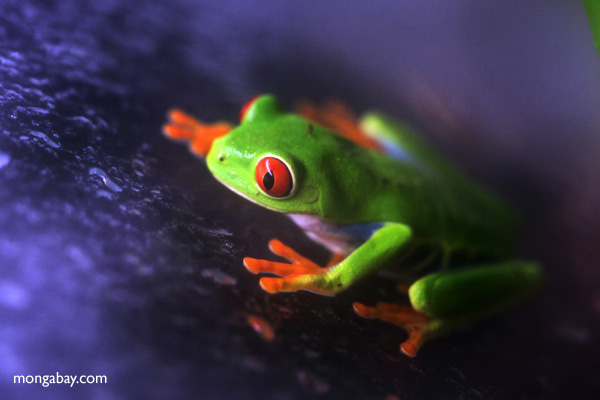
"Mongy, frogs can't fly!" I warned him. "You can say whatever you want. I put my mind to it, and I will fly!" "Mongy, that's not what Rhett and I said. We said you can do almost anything. But what we meant was that we could probably build something to help you fly. You will not learn how to fly. Some things are simply impossible!" "But I want to fly!" cried Mongy. "OK, Rhett will take you up in a helicopter later. He wants to take some photos of the rainforest and you can see what it's like to fly" For now Mongy was satisfied. After all, "helicopter" sounded a lot like "Lepidoptera", which means "butterfly". 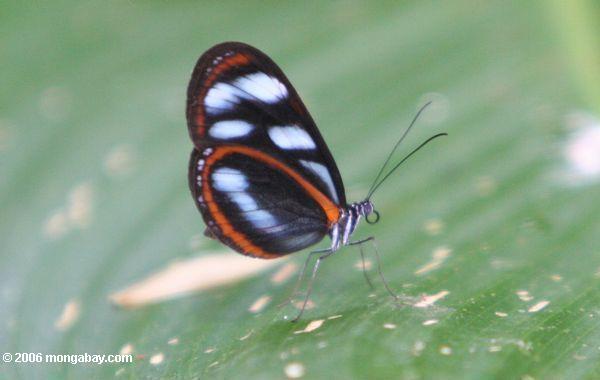
Rhett took off soon after lunch with Mongy in tow, wearing miniature goggles he had made out of plastic lids and a sort of leather jacket (which very suspiciously resembled my old leather pouch), looking very much like a miniature Charles Lindberg. Rhett went to inspect the impact of deforestation in the Amazon and the encroachment of pasture and farm land, and Mongy.... well; he had other things on his mind right now. Upon their return I met them at the helicopter pad. "Mongy how did you like your helicopter ride? I asked expectantly. "Well, I flew in a helicopter and Rhett even let me fly the helicopter and that was fun," replied Mongy. "But I didn't fly like a butterfly. I want to play with the wind. I'll have to keep practicing flying!" Later that day, while Mongy was consistently trying to improve his non-existing flying skills, I watched a swarm of butterflies and suddenly remembered something... "Mongy, Rhett, I am going to town." "Why" asked Mongy, who always wanted to know everything. "It's a surprise". I answered. 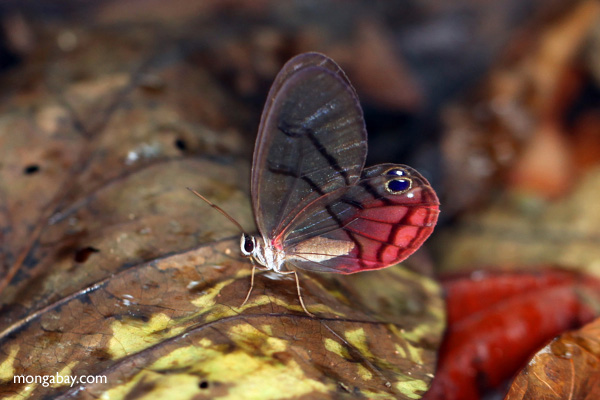
"Is it a flying one?" asked Mongy hopefully. "Yes. Just wait and see!" "OK. I'll wait right here then and I won't practice flying anymore and hurt myself when I fall errr... fly off that giant death-defying cliff." I heard Mongy calling after me as I entered my jeep. While shopping in town for supplies earlier that week, I remembered having seen a miniature version of a hang glider in a sporting goods shop. The manager was reluctant to sell it to me, but when I told him it was for a very important scientific experiment involving butterflies and frogs, he gave in. Next I went to a hobby shop and asked the craftsman to adapt a remote control to the contraption. We ran some tests and it worked fine. Finally, I went to a shoemaker and asked him to manufacture a miniature harness for Mongy. Imagine the face he made when I told him I had a frog who wanted to fly! "Estes gringos," he said to his assistant "cada idéia maluca eles têm". Which meant that I was a foreigner with crazy ideas, and I don't blame him for thinking that, although wanting to fly was Mongy's crazy idea. A few hours later I arrived back at our camp with a remote control mini hang glider in the back of my truck and was immediately confronted with a very impatient Mongy. "I have been waiting foooreeever!" he complained. "If I had known this would take so long, I would have continued practicing". Where's my flying surprise? I hope it's better than a helicopter!" "Well, Mongy it is. It's a hang glider. In Portuguese it's called "Asa Delta" and Asa means "wings". So, come here and let's strap this on and then you can jump off your death defying cliff again and go play with the wind." "All by myself?" 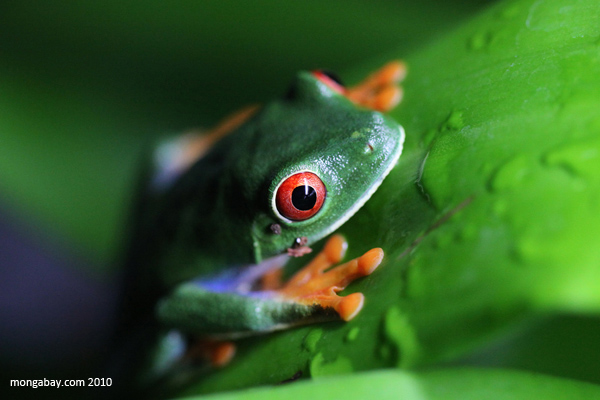
"Well, almost. I have had a remote control attached so that you’re safe. I don't want the wind to take you away and then you'll be lost forever in the rainforest. But I'll only use it if it's absolutely necessary, agreed? "Ok" agreed Mongy. "Better a little remote controlled and safe than lost again. But, really only use it in an emergency. " And with that, Mongy whom I had placed on the overhanging rock where he had so miserably failed to learn how to fly, whooshed off into the air. The butterflies had watched this whole spectacle and started to fly with him singing a Brazilian children's song that goes like this "O sapo não lava o pé. Ele tinha chulé. Ele mora lá na lagoa e não lava o pé porque não quer" Mongy, who understands Portuguese, would normally have been very upset about this song, which talks about a frog that lives in a lake and has stinky feet because it doesn't want to wash them. But this time Mongy the Bay Frog—who at that moment was the definitely, absolutely most-happiest frog in the world—just laughed and gleefully sang along: "I don't have stinky feet. 'Cause frogs are very clean. And now I am a flying frog while you butterflies can't swim!" Chapter 1: Meeting Mongy the Bay Frog Chapter 2: Mongy the Bay Frog's Family Chapter 3: Mongy the Bay Frog's meets Ringo the orangutan Chapter 4: Palm oil and rain forests Chapter 5: Mongy talks to a tree Chapter 6: Capture and escape! Chapter 7: In the Amazon Chapter 8: Butterflies |
 |
The Adventures of Mongy the Frog
|
|
|
|
worldrainforests.com/kids is published under a creative commons license.  
©2010 mongabay.com |
